Monitoring of Structures and Infrastructures by Low-Cost GNSS Receivers
Abstract
1. Introduction
2. Concepts
2.1. What We Want to Monitor
2.2. Absolute and Relative Positioning
2.3. Electronic Noise, Model Error and Estimation Errors
2.4. The a Posteriori Motion Model
- is the mean slow motion, which is a trend, and that could very well be when the point does not drift away from a reference mean position.
- is a true signal in due to external causes that, however, has a limited extent and is often periodic; as an example, one can think of mean temperature of seasons causing cycles of expansion and contraction of a concrete structure.
- represents an anomalous sudden change in the coordinate x. Characteristic of this term is its persistence. For instance, if represents a slip of a crack in the direction of x at epoch t, then the original position in x is not recovered in the subsequent epochs. This allows discrimination between this term and other anomalous changes that are included in . A clear example is presented in Figure 3.
- is the ordinary measurement noise propagated from the observations to the estimates through the least-squares algorithm.
- is that part of the model error in the observation equations that is absorbed into the parameter estimates by the least-squares algorithm. Typically, is smooth in time and can be treated as correlated (not white) noise. The presence of is, in fact, the reason why the estimation error provided by the least-squares adjustment is systematically too optimistic.
- is an outlier in the series ; namely, it is a value that at a specific epoch t is clearly far away from values at neighboring epochs and that can be smoothly interpolated. An example is given in Figure 3. Such values can be generated by a set of observations with a particularly unfavorable signal-to-noise ratio, by restricted sky visibility, and/or by some undetected cycle slip that can bias the estimates of the ambiguities and, consequently, of the coordinates, too.
- Represent by the linear combination of some shifted base functions; e.g., we use cubic splines,with parameters to be determined by interpolation and as the inter-distance (in time) between the central points of two consecutive splines. For instance, for daily solutions day), splines with an interdistance of 1 week have proved to be effective. In case of fast movements, interdistances might be shortened.
- Model as a linear response to one (or more) exogenous forces possibly shifted in timewhere T is the basic interval of the solutions (1 day, 1 h, …), are parameters to be adjusted to the data, and m is the “memory” distance of the influence of on x.
- Not model , verifying a posteriori whether there are jumps in the trajectory of that persist after the discontinuity epoch.
- Not model for the same reason as for the previous point.
- Modelas simple white noise because we have no idea of the exact stochastic model of this error.
2.5. Warnings and Alarms
- Q1: Is the deviation of from the slowly varying and predictable motion model statistically significant?
- Q2: Is the shift in assuming a critical value larger than a given structurally critical threshold ?
- (a1)
- In this case, the hypothesis H isand we want to verify whether there is evidence in the data that (17) is not correct.In this case, the critical threshold is simplyIt is clear that if we want to go with two tails, the test must verify whetherto accept H with the significance level .
- (a2)
- In this case, the hypothesis H we want to test iswhere is the threshold established by a structural engineer by considering that if (20) is verified, there is a risk to the stability of the structure.We then have to fix a critical value (when ), such that ifwe have a high probability of confirming H when this is true. Or, equivalently, we must haveLet us start with a simple hypothesis Hin this case, we have to imposeleading togiven the symmetry of the distribution of Z with respect to zero.Now it is clear that if we change H from (23) towe will have, with the same and c as in (24),namely, the choice of c is conservative in the sense that the probability of declaring H false because when, on the contrary, H is true, is even smaller than .Just to make a small example with realistic numbers, assume there is a series of hourly solutions with mm, and is fixed to cm; then is refused ifand cm is accepted if
3. The Experience
3.1. Many Examples
3.2. The Structure of the Bridge and Its Problems
3.3. The Network and the Installation on the Bridge
3.4. Hardware and Software
- Tallysman GNSS antenna and cables;
- Solar panel (30 W, 50 W, or 80 W) to provide electric power when it is not available on site;
- Box containing a battery (providing autonomy for 5–7 days), a GNSS receiver, memory and a transmission apparatus (based on u-blox SARA-U201 module);
- Low-cost, single-frequency, multi-constellation GNSS receiver (u-blox NEO-M8T) or low-cost, dual-frequency, multi-constellation GNSS receiver (u-blox ZED-F9T).
3.5. Results of Relative Motion
- C3–C1: very little motion of at most ∼1 cm over the 4 years in all the coordinates, a long-term very small negative trend in X and Y;
- C3–C2: marked seasonal signal with an amplitude of ∼2 cm in X (longitudinal) with clear annual periodicity;
- C3–C2: very small negative trend in Y up to March 2020, followed by a descent during springtime, a period in which ASPI had been working on the bridge. Although it is not covered by the displayed data, it is possible to prove stabilization of the descent after about 3 months;
- C3–C2: essential stability in Z with a pattern very similar to that of C3–C1.
3.6. Results of the Absolute Motion
4. Discussion and Perspectives
4.1. Discussion
4.2. Perspectives
- We strive to shorten the time unit of adjustments by going to 15–30 min in such a way as to improve latency while still remaining with RMS under 1 cm.
- Parallel experiments show that it is possible to combine GNSS observations with other sources of data, primarily inclinometers, to improve the monitoring capability of the system. Further, an external source of information, such as SAR, can be integrated into a unique solution.
- We expect that future data from monitoring sites will be endowed with specific expert systems that also combine completely different information, such as temperatures (of the air and the structure), the level of rain by pluviometers placed near the structure, and other ancillary variables such as the level of water of a river the bridge is crossing, or the level of water of an artificial lake barring the monitored dam.
Author Contributions
Funding
Institutional Review Board Statement
Informed Consent Statement
Data Availability Statement
Acknowledgments
Conflicts of Interest
Abbreviations
| ASPI | Autostrade per l’Italia |
| GNSS | Global Navigation Satellite System |
| GPS | Global Positioning System |
| GReD | Geomatics Research & Development |
| RMS | Root Mean Square |
| SAR | Synthetic Aperture Radar |
References
- DeLoach, S.R. Continuous deformation monitoring with GPS. J. Surv. Eng. 1989, 115, 93–110. [Google Scholar] [CrossRef]
- Bock, Y.; Shimada, S. Continuously monitoring GPS networks for deformation measurements. In Global Positioning System: An Overview; Springer: New York, NY, USA, 1990; pp. 40–56. [Google Scholar]
- Lovse, J.; Teskey, W.; Lachapelle, G.; Cannon, M. Dynamic deformation monitoring of tall structure using GPS technology. J. Surv. Eng. 1995, 121, 35–40. [Google Scholar] [CrossRef]
- Hudnut, K.W.; Behr, J.A. Continuous GPS monitoring of structural deformation at Pacoima Dam, California. Seismol. Res. Lett. 1998, 69, 299–308. [Google Scholar] [CrossRef]
- Reguzzoni, M.; Rossi, L.; De Gaetani, C.I.; Caldera, S.; Barzaghi, R. GNSS-Based Dam Monitoring: The Application of a Statistical Approach for Time Series Analysis to a Case Study. Appl. Sci. 2022, 12, 9981. [Google Scholar] [CrossRef]
- Fujino, Y.; Murata, M.; Okano, S.; Takeguchi, M. Monitoring system of the Akashi Kaikyo Bridge and displacement measurement using GPS. In Proceedings of the Nondestructive Evaluation of Highways, Utilities, and Pipelines IV, SPIE, Newport Beach, CA, USA, 9 June 2000; Volume 3995, pp. 229–236. [Google Scholar]
- Kaloop, M.R.; Li, H. Monitoring of bridge deformation using GPS technique. KSCE J. Civ. Eng. 2009, 13, 423–431. [Google Scholar] [CrossRef]
- Watson, C.; Watson, T.; Coleman, R. Structural monitoring of cable-stayed bridge: Analysis of GPS versus modeled deflections. J. Surv. Eng. 2007, 133, 23–28. [Google Scholar] [CrossRef]
- Bianchi, S.; Biondini, F.; Anghileri, M.; Capacci, L.; Rosati, G.; Cazzulani, G.; Caldera, S. GNSS-based structural monitoring of the Isola Dovarese Bridge, Italy. In Bridge Safety, Maintenance, Management, Life-Cycle, Resilience and Sustainability; CRC Press: Barcelona, Spain, 11–15 July 2022; pp. 1857–1863. [Google Scholar]
- Roberts, G.W.; Meng, X.; Dodson, A.H. Integrating a global positioning system and accelerometers to monitor the deflection of bridges. J. Surv. Eng. 2004, 130, 65–72. [Google Scholar] [CrossRef]
- Meng, X.; Roberts, G.W.; Dodson, A.H.; Ince, S.; Waugh, S. GNSS for structural deformation and deflection monitoring: Implementation and data analysis. In Proceedings of the 3rd IAG/12th FIG Symposium, Baden, Germany, 22–24 May 2006; pp. 22–24. [Google Scholar]
- Barzaghi, R.; Reguzzoni, M.; De Gaetani, C.I.; Caldera, S.; Rossi, L. Cultural heritage monitoring by low-cost gnss receivers: A feasibility study for san gaudenzio’s cupola, novara. Int. Arch. Photogramm. Remote Sens. Spat. Inf. Sci. 2019, XLII-2/W11, 209–216. [Google Scholar] [CrossRef]
- Šegina, E.; Peternel, T.; Urbančič, T.; Realini, E.; Zupan, M.; Jež, J.; Caldera, S.; Gatti, A.; Tagliaferro, G.; Consoli, A.; et al. Monitoring surface displacement of a deep-seated landslide by a low-cost and near real-time GNSS system. Remote Sens. 2020, 12, 3375. [Google Scholar] [CrossRef]
- Crosetto, M.; Luzi, G.; Monserrat, O.; Barra, A.; Cuevas-González, M.; Palamá, R.; Krishnakumar, V.; Wassie, Y.; Mirmazloumi, S.M.; Espín-López, P.; et al. Deformation monitoring using sar interferometry and active and passive reflectors. Int. Arch. Photogramm. Remote Sens. Spat. Inf. Sci. 2020, XLIII-B3-2020, 287–292. [Google Scholar] [CrossRef]
- Luzi, G.; Espín-López, P.F.; Mira Pérez, F.; Monserrat, O.; Crosetto, M. A Low-Cost Active Reflector for Interferometric Monitoring Based on Sentinel-1 SAR Images. Sensors 2021, 21, 2008. [Google Scholar] [CrossRef] [PubMed]
- Delo, G.; Civera, M.; Lenticchia, E.; Miraglia, G.; Surace, C.; Ceravolo, R. Interferometric Satellite Data in Structural Health Monitoring: An Application to the Effects of the Construction of a Subway Line in the Urban Area of Rome. Appl. Sci. 2022, 12, 1658. [Google Scholar] [CrossRef]
- Caldera, S.; Realini, E.; Reguzzoni, M.; Sampietro, D.; Sansò, F. GeoGuard: Un nuovo servizio di monitoraggio geodetico per l’osservazione di segnali geodinamici. In Proceedings of the 34° Convegno Nazionale GNGTS, Luglioprint, Trieste, Italy, 17–19 November 2015; pp. 83–88. [Google Scholar]
- Caldera, S.; Realini, E.; Barzaghi, R.; Reguzzoni, M.; Sansò, F. Experimental study on low-cost satellite-based geodetic monitoring over short baselines. J. Surv. Eng. 2016, 142, 04015016. [Google Scholar] [CrossRef]
- Sampietro, D.; Caldera, S.; Capponi, M.; Realini, E. Geoguard-An innovative technology based on low-cost GNSS receivers to monitor surface deformations. In Proceedings of the First EAGE Workshop on Practical Reservoir Monitoring, Amsterdam, The Netherlands, 6–9 March 2017; European Association of Geoscientists & Engineers: Amsterdam, The Netherlands, 2017; p. 505. [Google Scholar]
- Tagliaferro, G.; Caldera, S.; Realini, E.; Molinari, D.; Pasqui, L. GeoGuard: Low-cost GNSS technologies for the continuous monitoring of structures and land movements. In Proceedings of the EGU General Assembly Conference Abstracts, Vienna, Austria, 8–13 April 2018; p. 13898. [Google Scholar]
- Altamimi, Z.; Boucher, C.; Sillard, P. New trends for the realization of the International Terrestrial Reference System. Adv. Space Res. 2002, 30, 175–184. [Google Scholar] [CrossRef]
- Altamimi, Z.; Rebischung, P.; Métivier, L.; Collilieux, X. ITRF2014: A new release of the International Terrestrial Reference Frame modeling nonlinear station motions. J. Geophys. Res. Solid Earth 2016, 121, 6109–6131. [Google Scholar] [CrossRef]
- Tagliaferro, G.; Caldera, S. Impact of Double Differences Correlation on the Adjustment of Small GNSS Networks. J. Surv. Eng. 2019, 145, 04019002. [Google Scholar] [CrossRef]
- Hofmann-Wellenhof, B.; Lichtenegger, H.; Collins, J. Global Positioning System: Theory and Practice; Springer Science & Business Media: Vienna, Austria, 2012. [Google Scholar]
- Leick, A.; Rapoport, L.; Tatarnikov, D. GPS Satellite Surveying; John Wiley & Sons: Hoboken, NJ, USA, 2015. [Google Scholar]
- Teunissen, P.J.; Montenbruck, O. Springer Handbook of Global Navigation Satellite Systems; Springer: Cham, Switzerland, 2017; Volume 10. [Google Scholar]
- Sansò, F.; Betti, B.; Albertella, A. Positioning. Posizionamento Classico e Satellitare; CittàStudi Edizioni: Milan, Italy, 2019. [Google Scholar]
- Kouba, J. A Guide to Using International GNSS Service (IGS) Products. 2009. Available online: https://kb.igs.org/hc/en-us/articles/201271873-A-Guide-to-Using-the-IGS-Products (accessed on 30 October 2022).
- Johnston, G.; Riddell, A.; Hausler, G. The international GNSS service. In Springer Handbook of Global Navigation Satellite Systems; Springer: Cham, Switzerland, 2017; pp. 967–982. [Google Scholar]
- Bengio, Y. Learning Deep Architectures for AI; Now Publishers Inc.: Delft, The Netherlands, 2009. [Google Scholar]
- LeCun, Y.; Bengio, Y.; Hinton, G. Deep learning. Nature 2015, 521, 436–444. [Google Scholar] [CrossRef] [PubMed]
- Ruder, S. An overview of gradient descent optimization algorithms. arXiv 2016, arXiv:1609.04747. [Google Scholar]
- Cox, D.R.; Hinkley, D.V. Theoretical Statistics; CRC Press: Boca Raton, FL, USA, 1979. [Google Scholar]
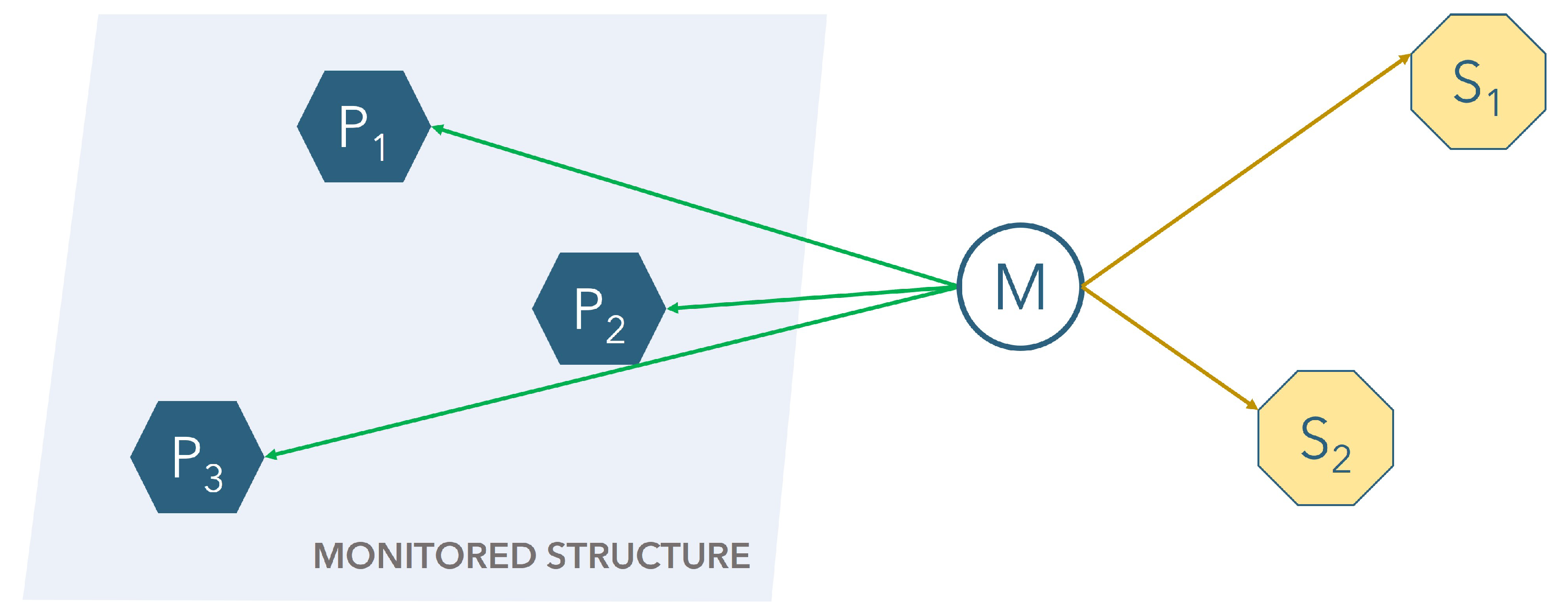


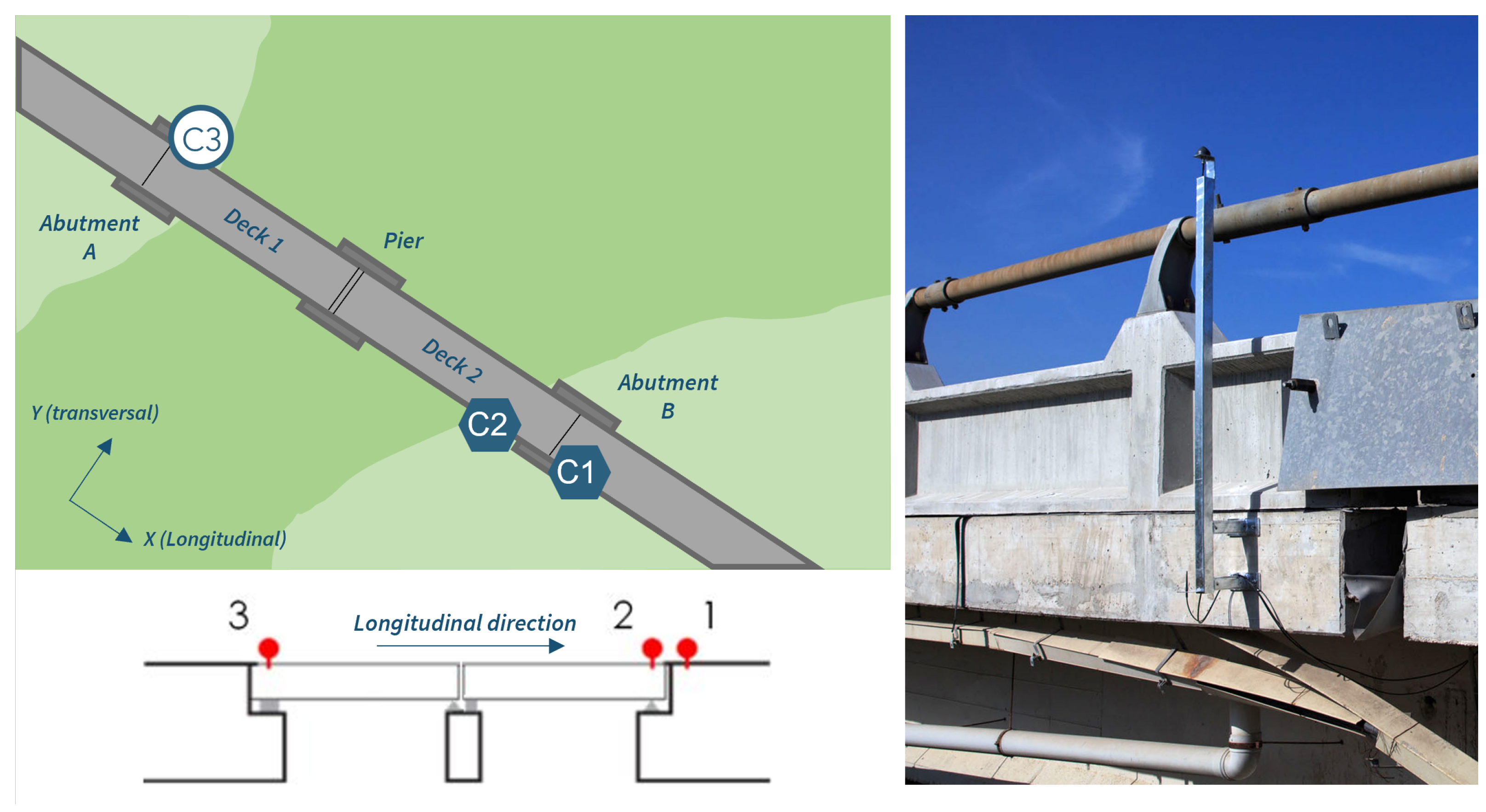
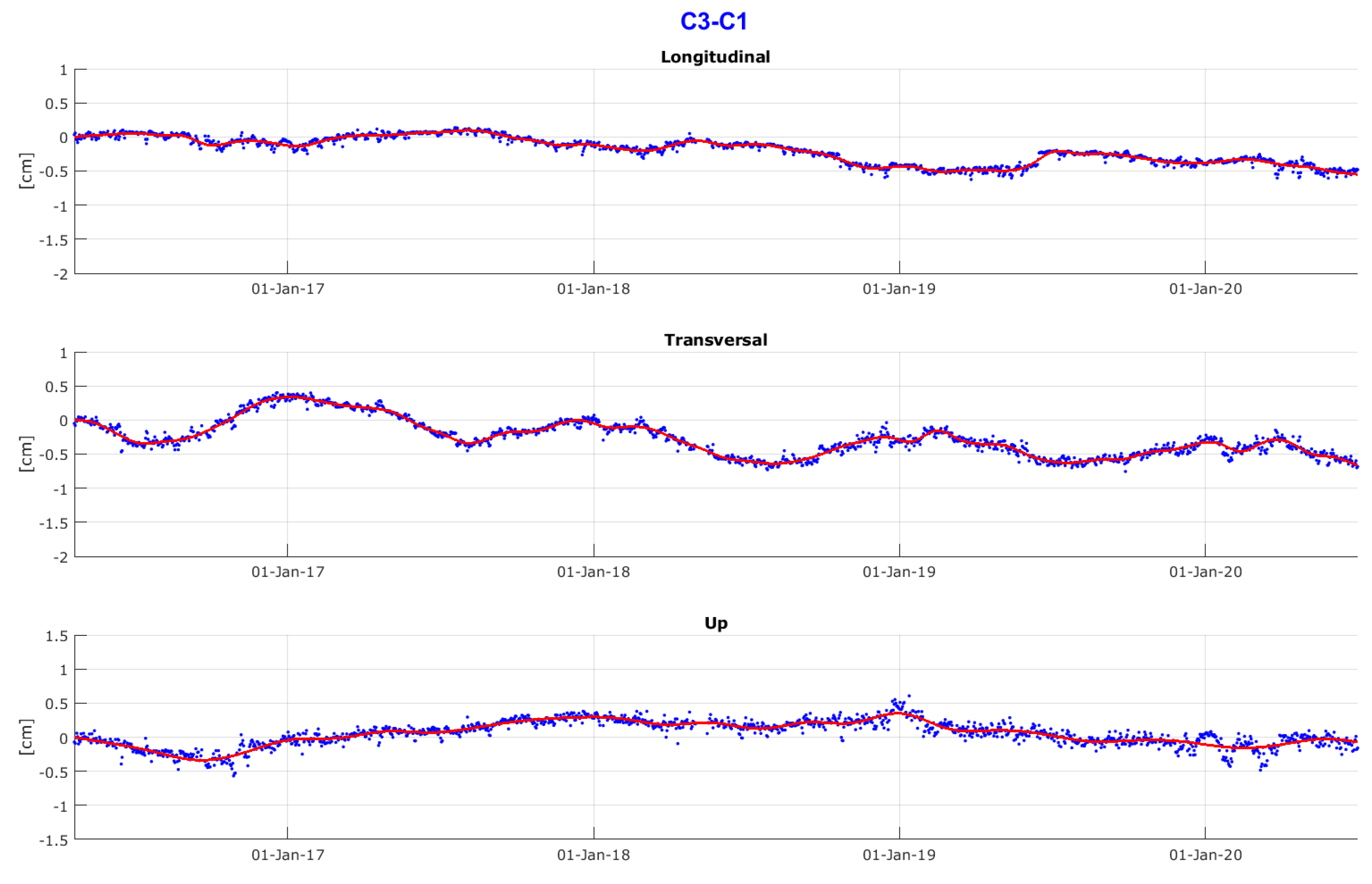
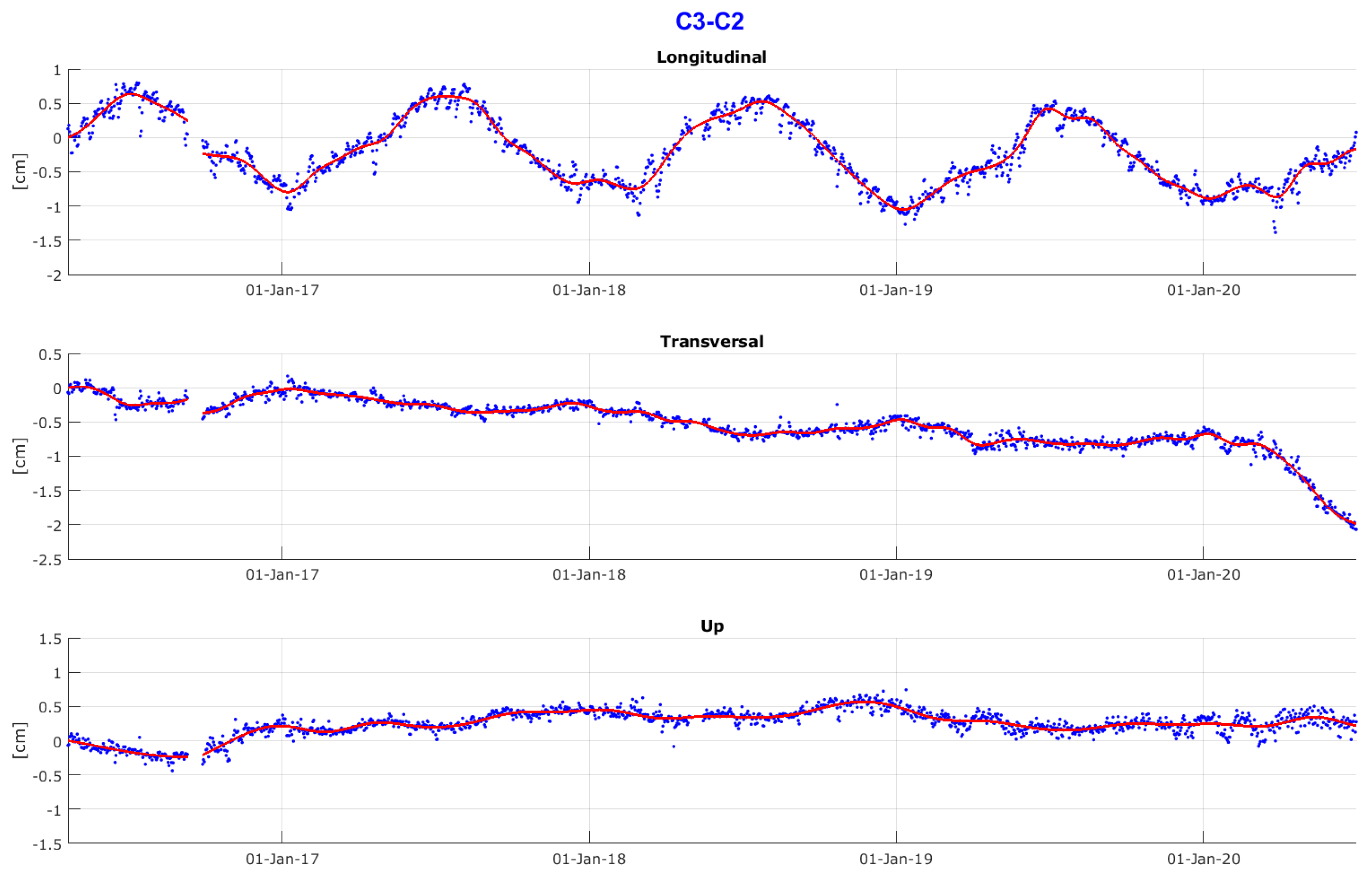
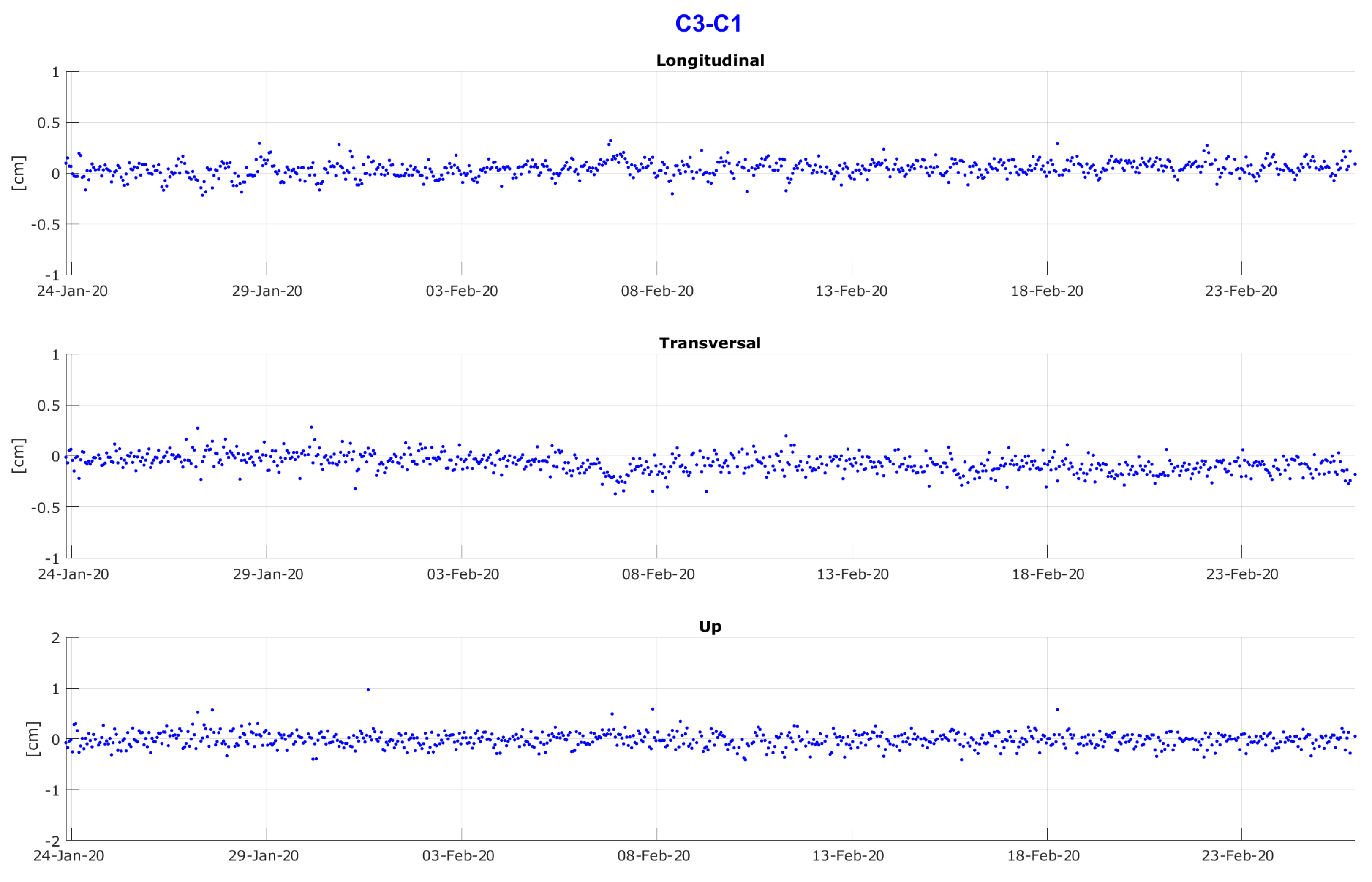
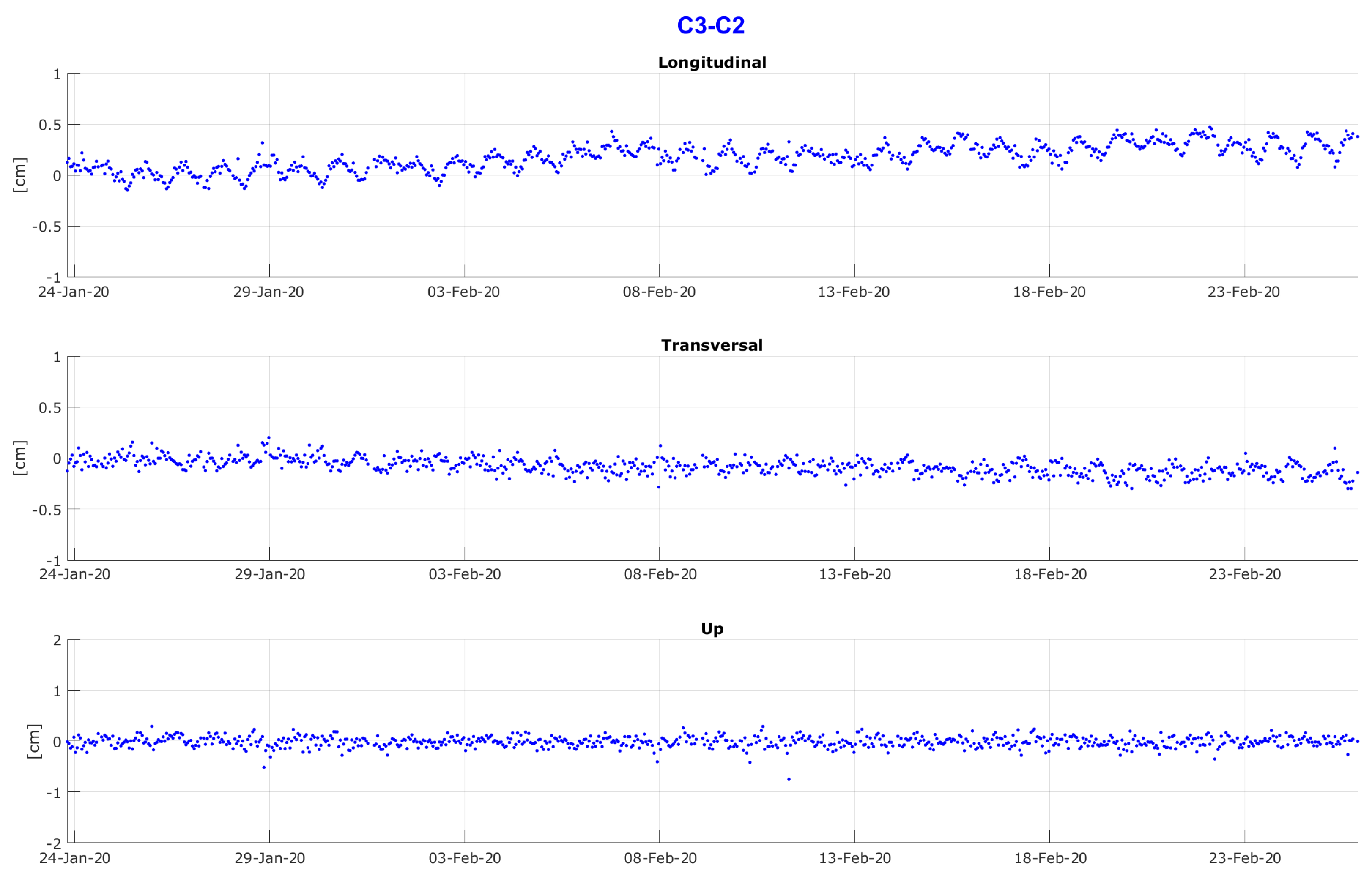
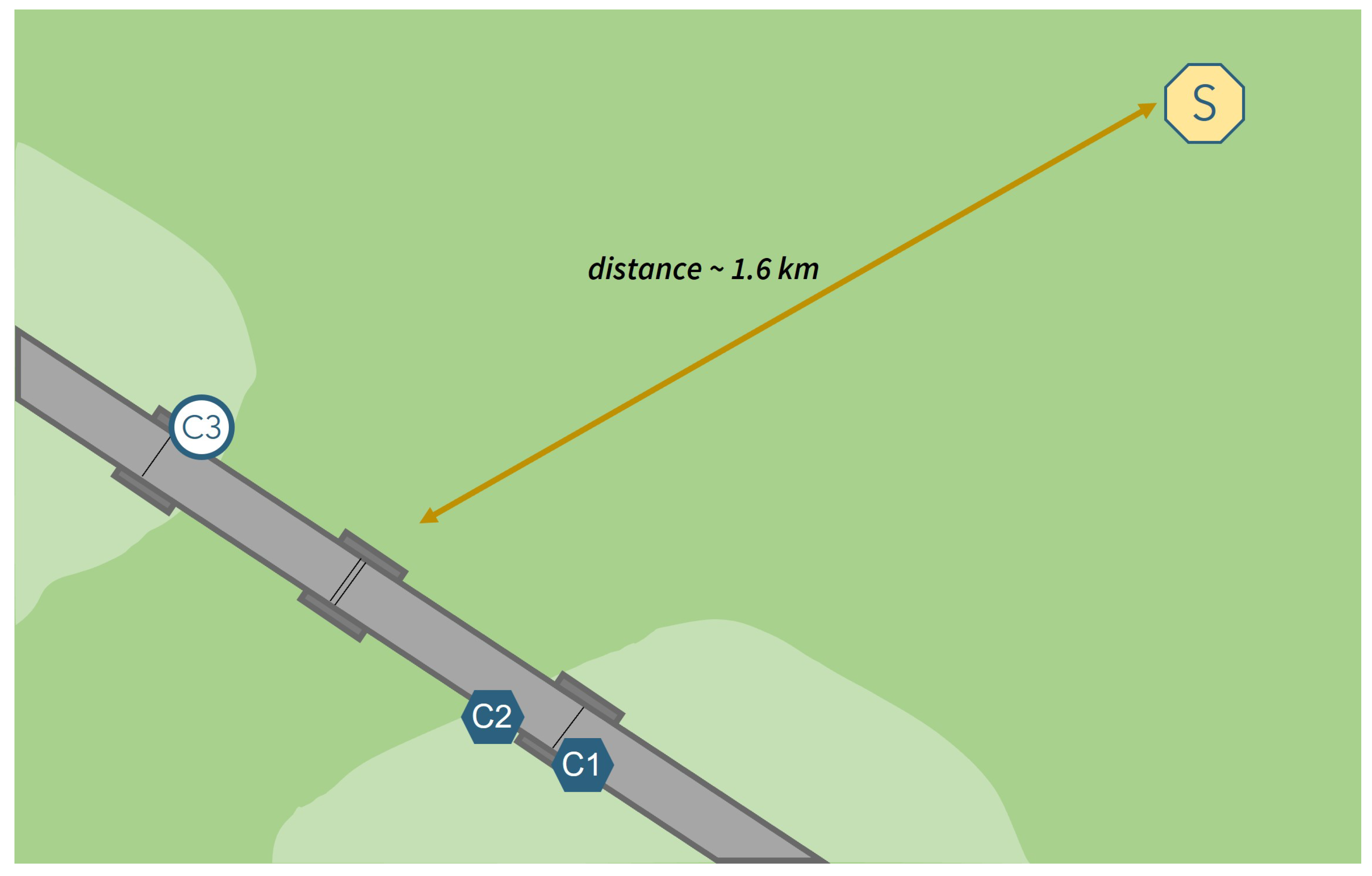
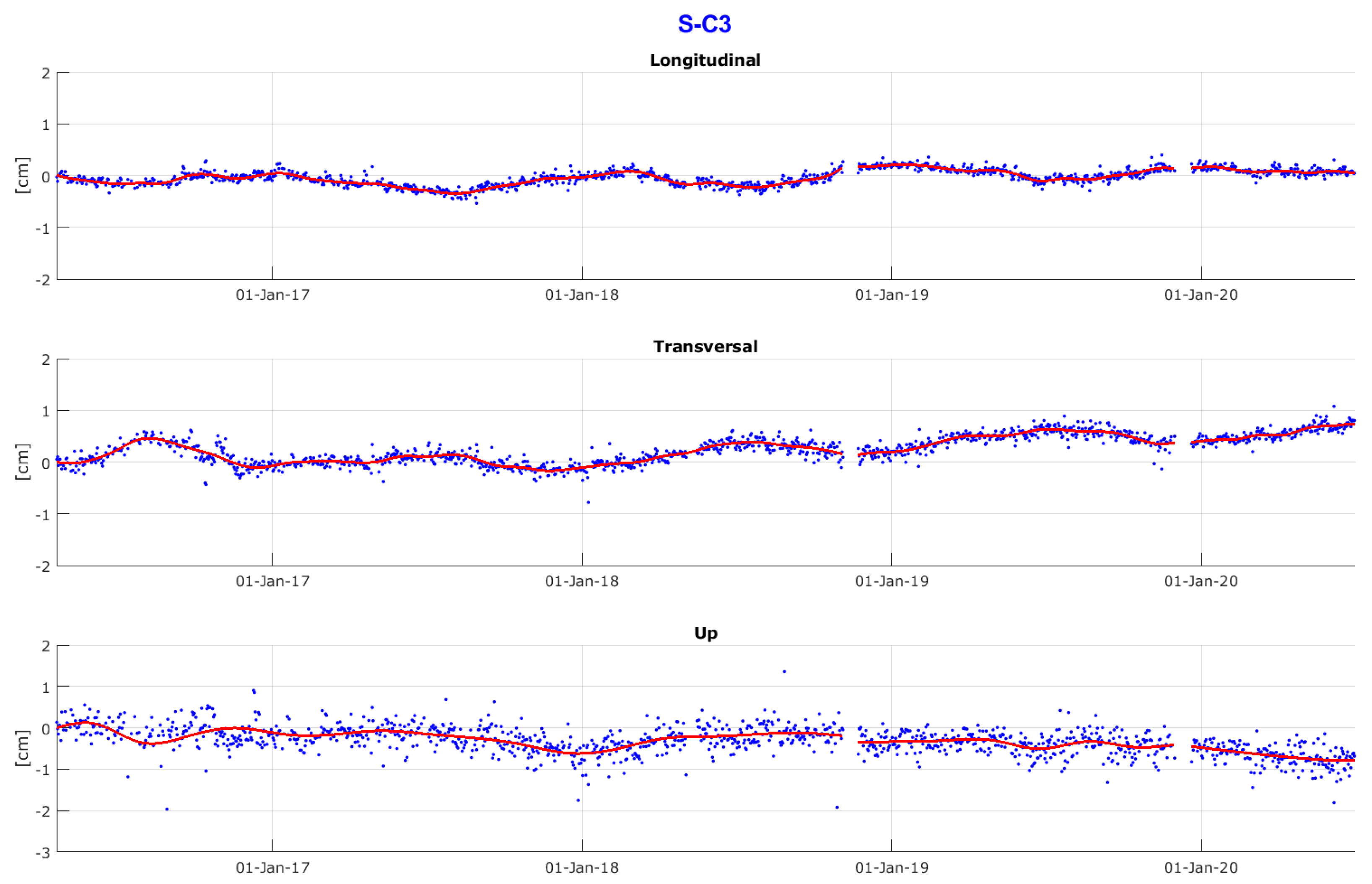
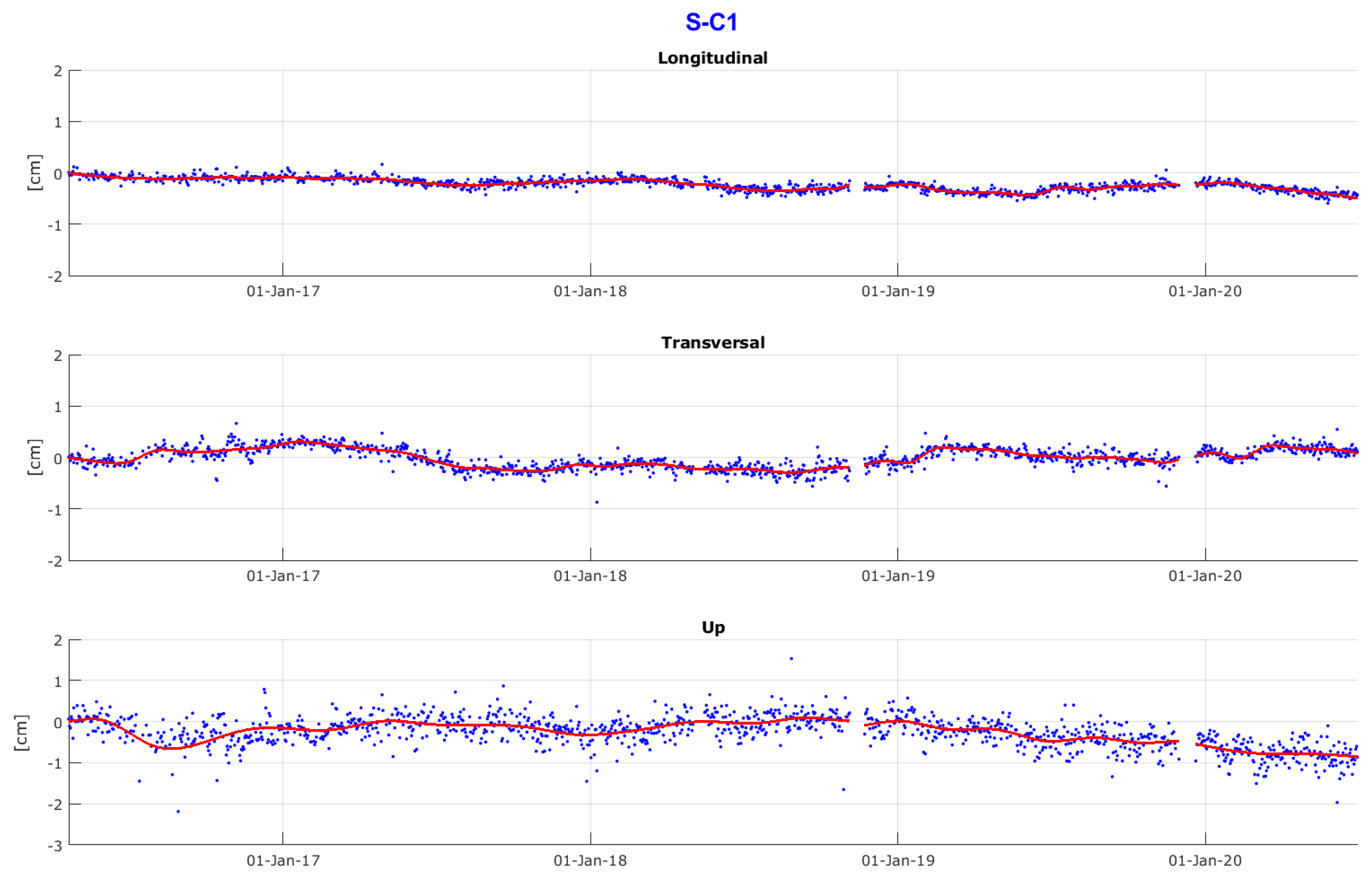

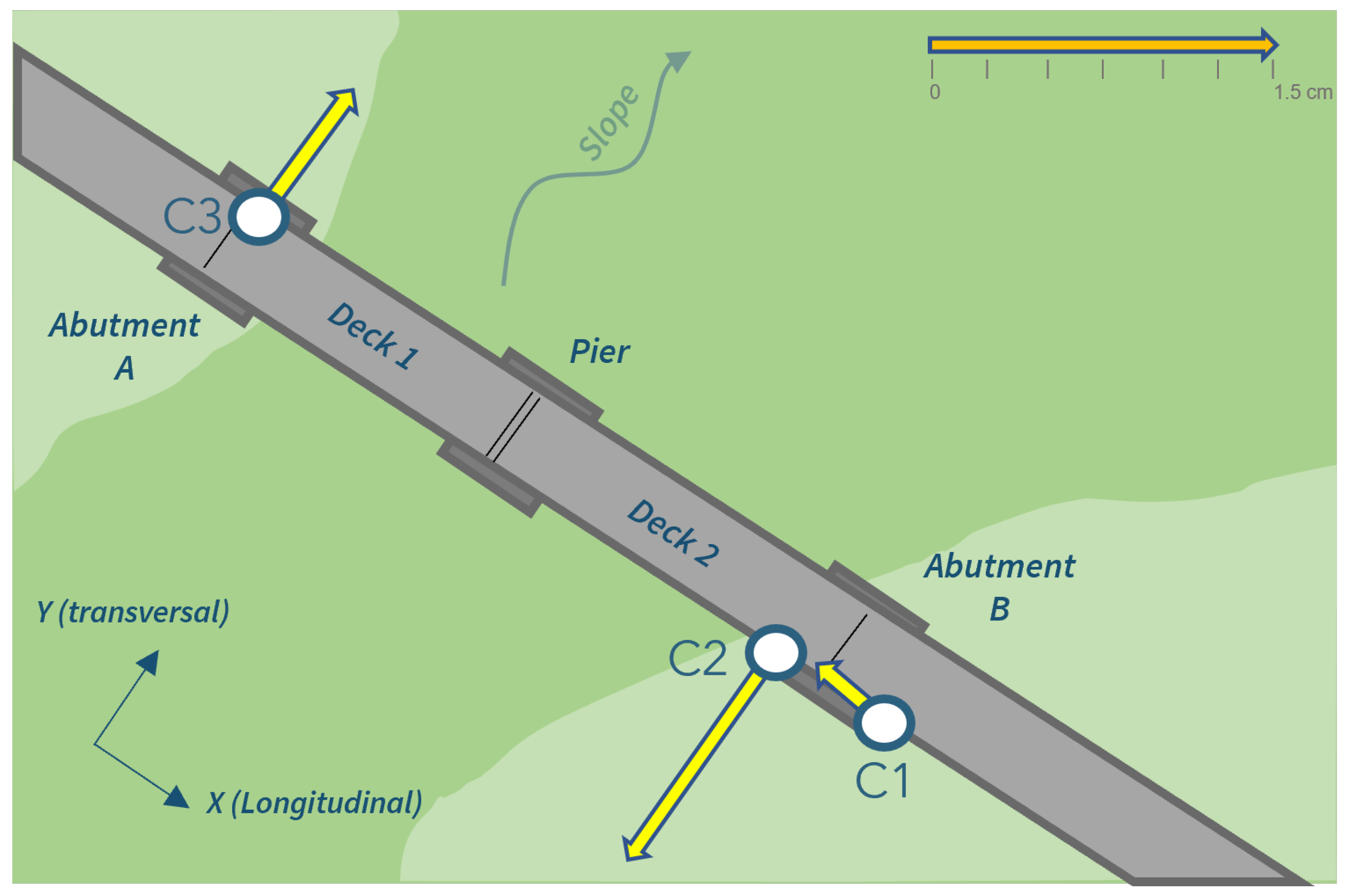
| Time Interval | Modality | Latency |
|---|---|---|
| 1 h (24 solutions per day) | Relative | 15 min after the end of the hour, for early warning |
| 2 h (12 solutions per day) | Relative | 15 min after the end of 2 h, to confirm the warning |
| 24 h (daily solution) | Relative/Absolute | Delivered after midnight |
| Baseline | Length | X (Longitudinal) | Y (Transversal) | Z (Up) |
|---|---|---|---|---|
| C3–C1 | 69.1 m | 0.4 mm | 0.5 mm | 0.7 mm |
| C3–C2 | 67.4 m | 1.1 mm | 0.6 mm | 0.7 mm |
| Baseline | Length | X (Longitudinal) | Y (Transversal) | Z (Up) |
|---|---|---|---|---|
| C3–C1 | horiz.: 69.1 m, vertic.: −0.4 m | 0.7 mm | 0.8 mm | 1.4 mm |
| C3–C2 | horiz.: 67.4 m, vertic.: −0.4 m | 0.9 mm | 0.7 mm | 1.1 mm |
| Baseline | Length | X (Longitudinal) | Y (Transversal) | Z (Up) |
|---|---|---|---|---|
| S–C1 | horiz.: 2390.5 m, vertic.: −214.6 m | 0.6 mm | 1.0 mm | 2.7 mm |
| S–C2 | horiz.: 2390.3 m, vertic.: −214.2 m | 1.1 mm | 1.0 mm | 2.7 mm |
| S–C3 | horiz.: 2405.2 m, vertic.: −214.2 m | 0.6 mm | 1.0 mm | 2.6 mm |
Publisher’s Note: MDPI stays neutral with regard to jurisdictional claims in published maps and institutional affiliations. |
© 2022 by the authors. Licensee MDPI, Basel, Switzerland. This article is an open access article distributed under the terms and conditions of the Creative Commons Attribution (CC BY) license (https://creativecommons.org/licenses/by/4.0/).
Share and Cite
Caldera, S.; Barindelli, S.; Sansò, F.; Pardi, L. Monitoring of Structures and Infrastructures by Low-Cost GNSS Receivers. Appl. Sci. 2022, 12, 12468. https://doi.org/10.3390/app122312468
Caldera S, Barindelli S, Sansò F, Pardi L. Monitoring of Structures and Infrastructures by Low-Cost GNSS Receivers. Applied Sciences. 2022; 12(23):12468. https://doi.org/10.3390/app122312468
Chicago/Turabian StyleCaldera, Stefano, Stefano Barindelli, Fernando Sansò, and Livia Pardi. 2022. "Monitoring of Structures and Infrastructures by Low-Cost GNSS Receivers" Applied Sciences 12, no. 23: 12468. https://doi.org/10.3390/app122312468
APA StyleCaldera, S., Barindelli, S., Sansò, F., & Pardi, L. (2022). Monitoring of Structures and Infrastructures by Low-Cost GNSS Receivers. Applied Sciences, 12(23), 12468. https://doi.org/10.3390/app122312468






